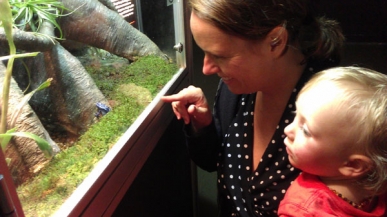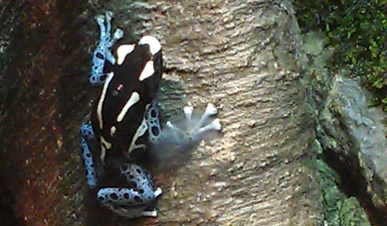Frogs behind glass bring wild frog declines into focus
My toddler son’s favorite counting song goes something like this –
Five green and speckled frogs/sat on a speckled log/eating some most delicious bugs/YUM-YUM!
One jumped into the pool/where it was nice and cool/then there were four green speckled frogs…
…always performed with hand gestures that pantomime chomping “most delicious bugs.”
He got an early start on his naturalist career in April this year, when, to our amazement, he found frog eggs tucked under a leaf along a small spring in Indiana. Knowing his love of all things froggy, we took him to the American Museum of Natural History in New York City to see their live frog exhibit, Frogs: A Chorus of Colors.

Eric Lorenz
As a parent and conservation scientist, I want my child to grow up in a world with frogs that he can search out in the wild, on his own. In the back of my mind, I was thinking at least he gets to see and appreciate these spectacular living jewels up close in a museum, before they go extinct.
After touring several other exhibits featuring fabulous but extinct creatures like Pterosaurs, Glyptodonts, and Lestodons, we finally made it to the very alive frogs. The bright red tomato frog, the Amazon milk frog, and the neon-hued poison dart frogs elicited excited “oooos” and “ohhhs” from my little guy. He was clearly impressed, but what really surprised me was my own thrilled reaction every time we found another one of these delicate gems tucked away in its miniature sculpted habitat.

Eric Lorenz
The impact of the frog exhibit was heightened for me by having first strolled amongst the skeletons of extinct creatures, pondering the fact that the next wave of mass extinctions is being driven by our own species, and frogs are on the frontline of the damage being done. Recent research shows that frogs and other amphibians are declining more rapidly than previously thought nationally (1), likely due to disease, habitat degradation and land use changes, water pollution, and global climate change. Climate scientists are also predicting that, without swift action, vast regions of the globe could soon become arid and uninhabitable for these denizens of damp places.
I could only wonder, as we finished our museum tour, what story archaeologists of the future might piece together when they unearth possibly extinct frog skeletons. We still have an opportunity to change this outcome so that our children can grow up searching for green, blue, and red speckled (or striped) frogs, but only if we take responsibility and act swiftly to get habitat loss, water pollution, and climate change under control.
1. Michael J. Adams et al., Trends in Amphibian Occupancy in the United States. PLOS One 8, (2013).











